Your Practice
"Whether India, Europe or America, people are searching for the same thing - true love.
Love and peace are universal. Wherever you taste honey, it is sweet...fire is
always hot." -
AmmaWe are all inherently the same and can benefit from some form of yoga practice
to help us find this love and peace we are searching for in our lives.
This said, we are all also different and therefore have the capacity to develop our own
unique yoga practice. This is why a personal practice, in a studio, at a gym, on the beach,
perhaps in your own home, or even at the office is so important.
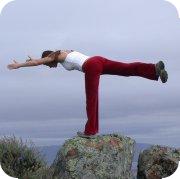
Many times you will attend a yoga class that is not exactly right for your needs that day.
You may go to a vigorous vinyasa class thinking that is what you need when in fact a more
restorative, yin class is best for you after that long strenuous bike ride. A slower practice would give
the quads a chance to relax and release so that you are ready for the next big ride.
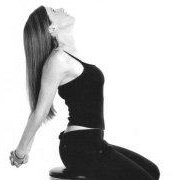
Taking some deep shoulder stretches might loosen you up a bit so you are ready for your next swimming session at
the pool. On the other hand if you have been sedentary, sitting in a chair at the office all day,
you may be in need of that vigorous yang practice to dispel some of the lethargy, stiffness and
lack of circulation. As you become more adept at knowing your body you will begin to
identify what it is you need from your yoga practice and a home practice can be an
excellent compliment and perhaps one day a replacement for going to a yoga studio
or gym to practice.
You may feel a home practice requires a higher level of self motivation and an amazing
sense of creativity. But just try it from time to time with no expectations.
Set aside 30 minutes of your day, roll out you mat and begin a few simple poses.
You might just find one pose flows from one to the next and before you know it a whole hour
has passed and you feel refreshed and rejuvenated unaware of the self discipline you have had to evoke.
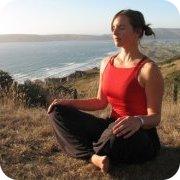
Start with your favorite poses, these are normally the ones you think you are good at.
Try to do these poses as though you have never done them before.
Try to notice something new about each of the poses every time you do them become aware of a
different part of the body, a part of the body that is not seemingly involved in the pose.
Relax and engage this part of the body and notice the affect this has.
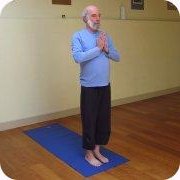
If you are ever in doubt of the correct alignment in a pose, revert back
to Tadasana for the ideal alignment. Crown of head reaching away from tailbone,
back of the neck long and in line with the rest of the spine, shoulder blades in a
neutral position moving slightly inwards and down the back, away from the ears,
sternum is lifted, keeping upper spine lengthening and not rounded, solar plexus
is soft and yet the abdominal muscles are slightly contracted giving the lower
back support and preserving its natural concave curve, the tailbone is slightly
tucked reaching away from the crown of the head, hips are even and level with one
another, buttocks are relaxed so as not to cause any compression in the lower back and sacral area.
The thighs are either working to rotate in or out. This is to keep the knee central and inline
with the space between the second and third toes.
If the arms are reaching upwards the shoulders have to work to move downwards.
This is especially important in poses like Downward Dog where we all have a tendency to scrunch
the shoulders up besides the ears. Come out of the pose a little deepen the armpits and move
the shoulders down the back to release the tops of the trapezoids.
Generally you want to always be stretching in the belly of the muscle and not the ligaments that
attach these muscles to the bone. Ligaments are inelastic and will not return to their formal
length. Stretching muscles can sometimes be painful. You will soon learn the difference
between a good stretch and a bad one (a strain).
Always breathe into a stretch. Do not flop into a pose with out engaging the muscles
required to safely hold you there. Every pose has a muscle working and a muscle releasing.
Try to identify different parts of your body in a pose and how they are feeling.
To find more release take your thoughts away from the pain in the stretch and focus on the breath.
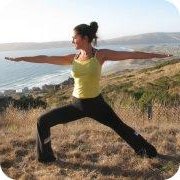
The only difference between a flexible person and an inflexible person is a flexible
person has to go deeper into a pose in order to feel something. This is a prime example
of how every pose correctly done is different for everyone, depending on our individual
flexibility. If you are flexible be aware it is very easy to injure yourself by flopping
into a pose with out engaging the muscles required to hold you there and prevent you
from
over-stretching.
Overstretching is when you no longer have any more stretch left in the muscle - it is stretched
to it's fullest length and you begin to take the stretch into the ligaments and tendons at
either end of the muscle. An example of this is
yoga butt in a forward fold.
The hamstrings are so loose that the ligaments at the tops of the hamstrings,
just beneath the buttocks stretch and become very painful. To prevent this, engage
the quads and don't lock the knees. Take a micro bend in the knees. The important thing is
not whether you can reach you toes but whether your spine is lengthening. Range is of the
ego and Form is of the soul.
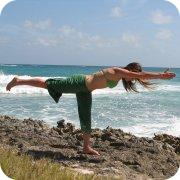
What ever you do, have fun with your yoga practice. Make a noise, flow quick or slowly
depending on your mood. Above all remember there is no perfect pose.
As long as you are finding your edge in the challenge,
honouring yourself by being true to that limit, unattached to the results and
as a result remaining calm, unreactive and able to breath slowly and deeply,
you are doing the pose perfectly. Do not feel like you have to conform to a pose,
consult a qualified teacher about how to modify and adapt the poses to conform to you.
Remember you may do absolutely nothing except just lie still, but as long as you are breathing
full and complete breaths, and making that all important
attempt to be mindful of this breath, you are doing yoga.
Holding the breath is a sign of being frightened, startled, thinking to hard, or being angry.
In our yoga practice we want to rid ourselves of these stresses and anxiety and create a relaxed
and calm state of mind letting experiences and thoughts flow through us.
Instead of becoming absorbed by thoughts and emotions (fluctuations of the mind)
we let them come...and then we let them go again.
We do this by staying
inbetween the inhale and the exhale. In other words by keeping the breath flowing,
and maintaining concentration on this flow of breath, we become detach from our planning or worrying thoughts
and as a result end up letting go of stress.
A common question is "What's wrong with thinking or feeling, or even experiencing emotions?"
That's all fine. Through our yoga practice we learn to let go of these common human emotions such as anger,
sadness or even elation when they no longer serve us.
By practicing yoga we learn how to control the way we react to the outside world not getting so caught up in it.
We are aware of our feelings of happiness, sadness, anger but we let these feeling go before they begin to harm us.
Through practicing yoga we learn how to return the body to a state of calm before it becomes depleted,
worn out susceptible to infection, bad digestion, insomnia, high blood pressure etc.
We learn to keep the body and mind at
ease and away from
disease.
Yoga provides a set of tools to help us maintain a healthy body and a healthy mind fro a life free of suffering.
Have a wonderful journey! You are your own teacher. Listen to your body. Listen to your Self.
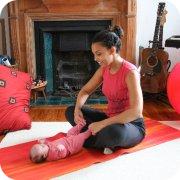
Have you been recently injured or are you pregnant? Please feel free to contact Ten Toes Yoga to discuss your individual needs or concerns.
 Many times you will attend a yoga class that is not exactly right for your needs that day.
You may go to a vigorous vinyasa class thinking that is what you need when in fact a more
restorative, yin class is best for you after that long strenuous bike ride. A slower practice would give
the quads a chance to relax and release so that you are ready for the next big ride.
Many times you will attend a yoga class that is not exactly right for your needs that day.
You may go to a vigorous vinyasa class thinking that is what you need when in fact a more
restorative, yin class is best for you after that long strenuous bike ride. A slower practice would give
the quads a chance to relax and release so that you are ready for the next big ride.
 Taking some deep shoulder stretches might loosen you up a bit so you are ready for your next swimming session at
the pool. On the other hand if you have been sedentary, sitting in a chair at the office all day,
you may be in need of that vigorous yang practice to dispel some of the lethargy, stiffness and
lack of circulation. As you become more adept at knowing your body you will begin to
identify what it is you need from your yoga practice and a home practice can be an
excellent compliment and perhaps one day a replacement for going to a yoga studio
or gym to practice.You may feel a home practice requires a higher level of self motivation and an amazing
sense of creativity. But just try it from time to time with no expectations.
Set aside 30 minutes of your day, roll out you mat and begin a few simple poses.
You might just find one pose flows from one to the next and before you know it a whole hour
has passed and you feel refreshed and rejuvenated unaware of the self discipline you have had to evoke.
Taking some deep shoulder stretches might loosen you up a bit so you are ready for your next swimming session at
the pool. On the other hand if you have been sedentary, sitting in a chair at the office all day,
you may be in need of that vigorous yang practice to dispel some of the lethargy, stiffness and
lack of circulation. As you become more adept at knowing your body you will begin to
identify what it is you need from your yoga practice and a home practice can be an
excellent compliment and perhaps one day a replacement for going to a yoga studio
or gym to practice.You may feel a home practice requires a higher level of self motivation and an amazing
sense of creativity. But just try it from time to time with no expectations.
Set aside 30 minutes of your day, roll out you mat and begin a few simple poses.
You might just find one pose flows from one to the next and before you know it a whole hour
has passed and you feel refreshed and rejuvenated unaware of the self discipline you have had to evoke. Start with your favorite poses, these are normally the ones you think you are good at.
Try to do these poses as though you have never done them before.
Try to notice something new about each of the poses every time you do them become aware of a
different part of the body, a part of the body that is not seemingly involved in the pose.
Relax and engage this part of the body and notice the affect this has.
Start with your favorite poses, these are normally the ones you think you are good at.
Try to do these poses as though you have never done them before.
Try to notice something new about each of the poses every time you do them become aware of a
different part of the body, a part of the body that is not seemingly involved in the pose.
Relax and engage this part of the body and notice the affect this has. If you are ever in doubt of the correct alignment in a pose, revert back
to Tadasana for the ideal alignment. Crown of head reaching away from tailbone,
back of the neck long and in line with the rest of the spine, shoulder blades in a
neutral position moving slightly inwards and down the back, away from the ears,
sternum is lifted, keeping upper spine lengthening and not rounded, solar plexus
is soft and yet the abdominal muscles are slightly contracted giving the lower
back support and preserving its natural concave curve, the tailbone is slightly
tucked reaching away from the crown of the head, hips are even and level with one
another, buttocks are relaxed so as not to cause any compression in the lower back and sacral area.
The thighs are either working to rotate in or out. This is to keep the knee central and inline
with the space between the second and third toes.
If the arms are reaching upwards the shoulders have to work to move downwards.
This is especially important in poses like Downward Dog where we all have a tendency to scrunch
the shoulders up besides the ears. Come out of the pose a little deepen the armpits and move
the shoulders down the back to release the tops of the trapezoids.
Generally you want to always be stretching in the belly of the muscle and not the ligaments that
attach these muscles to the bone. Ligaments are inelastic and will not return to their formal
length. Stretching muscles can sometimes be painful. You will soon learn the difference
between a good stretch and a bad one (a strain).
Always breathe into a stretch. Do not flop into a pose with out engaging the muscles
required to safely hold you there. Every pose has a muscle working and a muscle releasing.
Try to identify different parts of your body in a pose and how they are feeling.
To find more release take your thoughts away from the pain in the stretch and focus on the breath.
If you are ever in doubt of the correct alignment in a pose, revert back
to Tadasana for the ideal alignment. Crown of head reaching away from tailbone,
back of the neck long and in line with the rest of the spine, shoulder blades in a
neutral position moving slightly inwards and down the back, away from the ears,
sternum is lifted, keeping upper spine lengthening and not rounded, solar plexus
is soft and yet the abdominal muscles are slightly contracted giving the lower
back support and preserving its natural concave curve, the tailbone is slightly
tucked reaching away from the crown of the head, hips are even and level with one
another, buttocks are relaxed so as not to cause any compression in the lower back and sacral area.
The thighs are either working to rotate in or out. This is to keep the knee central and inline
with the space between the second and third toes.
If the arms are reaching upwards the shoulders have to work to move downwards.
This is especially important in poses like Downward Dog where we all have a tendency to scrunch
the shoulders up besides the ears. Come out of the pose a little deepen the armpits and move
the shoulders down the back to release the tops of the trapezoids.
Generally you want to always be stretching in the belly of the muscle and not the ligaments that
attach these muscles to the bone. Ligaments are inelastic and will not return to their formal
length. Stretching muscles can sometimes be painful. You will soon learn the difference
between a good stretch and a bad one (a strain).
Always breathe into a stretch. Do not flop into a pose with out engaging the muscles
required to safely hold you there. Every pose has a muscle working and a muscle releasing.
Try to identify different parts of your body in a pose and how they are feeling.
To find more release take your thoughts away from the pain in the stretch and focus on the breath.
 The only difference between a flexible person and an inflexible person is a flexible
person has to go deeper into a pose in order to feel something. This is a prime example
of how every pose correctly done is different for everyone, depending on our individual
flexibility. If you are flexible be aware it is very easy to injure yourself by flopping
into a pose with out engaging the muscles required to hold you there and prevent you
from over-stretching.
Overstretching is when you no longer have any more stretch left in the muscle - it is stretched
to it's fullest length and you begin to take the stretch into the ligaments and tendons at
either end of the muscle. An example of this is yoga butt in a forward fold.
The hamstrings are so loose that the ligaments at the tops of the hamstrings,
just beneath the buttocks stretch and become very painful. To prevent this, engage
the quads and don't lock the knees. Take a micro bend in the knees. The important thing is
not whether you can reach you toes but whether your spine is lengthening. Range is of the
ego and Form is of the soul.
The only difference between a flexible person and an inflexible person is a flexible
person has to go deeper into a pose in order to feel something. This is a prime example
of how every pose correctly done is different for everyone, depending on our individual
flexibility. If you are flexible be aware it is very easy to injure yourself by flopping
into a pose with out engaging the muscles required to hold you there and prevent you
from over-stretching.
Overstretching is when you no longer have any more stretch left in the muscle - it is stretched
to it's fullest length and you begin to take the stretch into the ligaments and tendons at
either end of the muscle. An example of this is yoga butt in a forward fold.
The hamstrings are so loose that the ligaments at the tops of the hamstrings,
just beneath the buttocks stretch and become very painful. To prevent this, engage
the quads and don't lock the knees. Take a micro bend in the knees. The important thing is
not whether you can reach you toes but whether your spine is lengthening. Range is of the
ego and Form is of the soul. What ever you do, have fun with your yoga practice. Make a noise, flow quick or slowly
depending on your mood. Above all remember there is no perfect pose.
As long as you are finding your edge in the challenge,
honouring yourself by being true to that limit, unattached to the results and
as a result remaining calm, unreactive and able to breath slowly and deeply,
you are doing the pose perfectly. Do not feel like you have to conform to a pose,
consult a qualified teacher about how to modify and adapt the poses to conform to you.
Remember you may do absolutely nothing except just lie still, but as long as you are breathing
full and complete breaths, and making that all important attempt to be mindful of this breath, you are doing yoga.
Holding the breath is a sign of being frightened, startled, thinking to hard, or being angry.
In our yoga practice we want to rid ourselves of these stresses and anxiety and create a relaxed
and calm state of mind letting experiences and thoughts flow through us.
Instead of becoming absorbed by thoughts and emotions (fluctuations of the mind)
we let them come...and then we let them go again.
We do this by staying inbetween the inhale and the exhale. In other words by keeping the breath flowing,
and maintaining concentration on this flow of breath, we become detach from our planning or worrying thoughts
and as a result end up letting go of stress.
A common question is "What's wrong with thinking or feeling, or even experiencing emotions?"
That's all fine. Through our yoga practice we learn to let go of these common human emotions such as anger,
sadness or even elation when they no longer serve us.
By practicing yoga we learn how to control the way we react to the outside world not getting so caught up in it.
We are aware of our feelings of happiness, sadness, anger but we let these feeling go before they begin to harm us.
Through practicing yoga we learn how to return the body to a state of calm before it becomes depleted,
worn out susceptible to infection, bad digestion, insomnia, high blood pressure etc.
We learn to keep the body and mind at ease and away from disease.
Yoga provides a set of tools to help us maintain a healthy body and a healthy mind fro a life free of suffering.
Have a wonderful journey! You are your own teacher. Listen to your body. Listen to your Self.
What ever you do, have fun with your yoga practice. Make a noise, flow quick or slowly
depending on your mood. Above all remember there is no perfect pose.
As long as you are finding your edge in the challenge,
honouring yourself by being true to that limit, unattached to the results and
as a result remaining calm, unreactive and able to breath slowly and deeply,
you are doing the pose perfectly. Do not feel like you have to conform to a pose,
consult a qualified teacher about how to modify and adapt the poses to conform to you.
Remember you may do absolutely nothing except just lie still, but as long as you are breathing
full and complete breaths, and making that all important attempt to be mindful of this breath, you are doing yoga.
Holding the breath is a sign of being frightened, startled, thinking to hard, or being angry.
In our yoga practice we want to rid ourselves of these stresses and anxiety and create a relaxed
and calm state of mind letting experiences and thoughts flow through us.
Instead of becoming absorbed by thoughts and emotions (fluctuations of the mind)
we let them come...and then we let them go again.
We do this by staying inbetween the inhale and the exhale. In other words by keeping the breath flowing,
and maintaining concentration on this flow of breath, we become detach from our planning or worrying thoughts
and as a result end up letting go of stress.
A common question is "What's wrong with thinking or feeling, or even experiencing emotions?"
That's all fine. Through our yoga practice we learn to let go of these common human emotions such as anger,
sadness or even elation when they no longer serve us.
By practicing yoga we learn how to control the way we react to the outside world not getting so caught up in it.
We are aware of our feelings of happiness, sadness, anger but we let these feeling go before they begin to harm us.
Through practicing yoga we learn how to return the body to a state of calm before it becomes depleted,
worn out susceptible to infection, bad digestion, insomnia, high blood pressure etc.
We learn to keep the body and mind at ease and away from disease.
Yoga provides a set of tools to help us maintain a healthy body and a healthy mind fro a life free of suffering.
Have a wonderful journey! You are your own teacher. Listen to your body. Listen to your Self. Have you been recently injured or are you pregnant? Please feel free to contact Ten Toes Yoga to discuss your individual needs or concerns.
Have you been recently injured or are you pregnant? Please feel free to contact Ten Toes Yoga to discuss your individual needs or concerns.